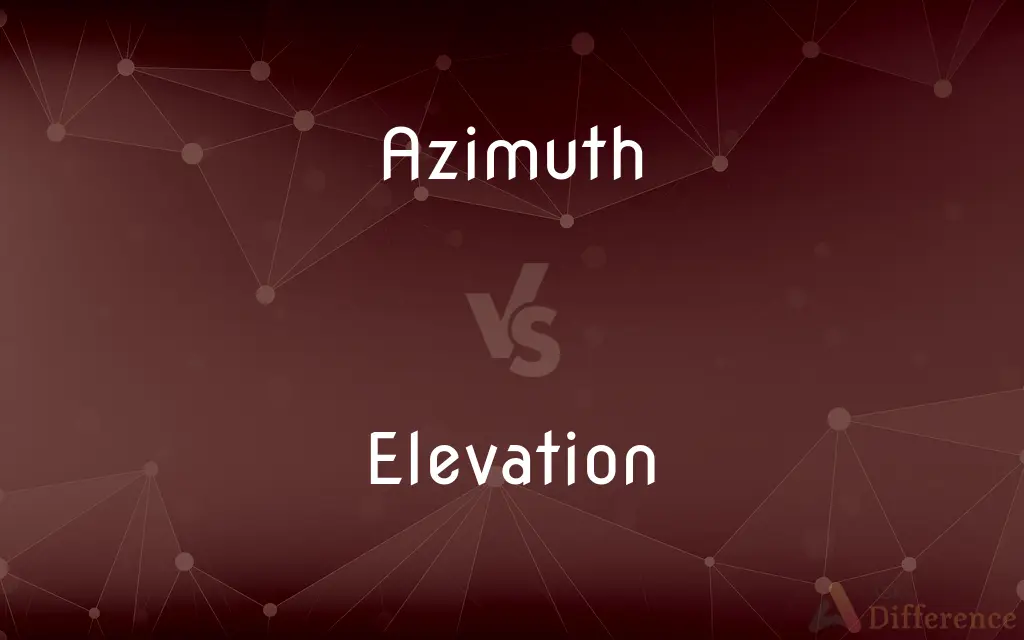Azimuth vs. Elevation — What's the Difference?
By Tayyaba Rehman — Updated on October 31, 2023
Azimuth measures horizontal angles from a reference direction, while elevation measures vertical angles from the horizontal plane.

Difference Between Azimuth and Elevation
Table of Contents
ADVERTISEMENT
Key Differences
Azimuth refers to the horizontal angle measured clockwise from a reference direction, often north. Elevation, on the other hand, measures the angle upward from the horizontal plane.
When locating a celestial body, azimuth determines the compass direction, while elevation indicates the body's height above the horizon.
In satellite communication, azimuth defines the compass direction to point the antenna. Conversely, elevation determines the angle above the horizon to tilt the antenna.
Azimuth is measured in degrees from 0 to 360, providing a full circular rotation. Elevation also uses degrees, but typically ranges from 0 (horizon) to 90 (directly overhead).
In navigation and astronomy, azimuth helps in identifying horizontal direction, whereas elevation assists in understanding vertical positioning relative to the observer’s location.
ADVERTISEMENT
Comparison Chart
Reference Plane
Measured from a reference direction, usually north, in a horizontal plane.
Measured from the horizontal plane, vertically above or below.
Measurement Units
Degrees (°), usually from 0° to 360°.
Degrees (°), typically ranging from -90° to 90°.
Applications
Navigation, astronomy, satellite communication, photography.
Aviation, topography, architecture, astronomy.
Relation to Horizon
Parallel to the horizon, determining direction.
Perpendicular to the horizon, determining height or altitude.
Importance
Essential for horizontal positioning and direction finding.
Critical for understanding vertical positioning and height.
Compare with Definitions
Azimuth
Azimuth is used in navigation to express the direction of travel.
The captain set the ship's course at an azimuth of 135 degrees.
Elevation
Elevation is the height of a point above sea level.
The mountain’s elevation is 8,000 feet above sea level.
Azimuth
Azimuth is the angle between a reference direction and a point.
The azimuth from north to the mountain peak was 45 degrees.
Elevation
The elevation of a geographic location is its height above or below a fixed reference point, most commonly a reference geoid, a mathematical model of the Earth's sea level as an equipotential gravitational surface (see Geodetic datum § Vertical datum). The term elevation is mainly used when referring to points on the Earth's surface, while altitude or geopotential height is used for points above the surface, such as an aircraft in flight or a spacecraft in orbit, and depth is used for points below the surface.
Azimuth
In astronomy, azimuth indicates the horizontal direction of a celestial body.
The azimuth of the moon helped the astronomers align their telescopes.
Elevation
The act or an instance of elevating
The slow elevation of body temperature.
Azimuth
It’s a geographic tool to specify the direction of a location.
The azimuth to the nearest town from our campsite was due east.
Elevation
The condition of being elevated
Her elevation among scholars.
Azimuth
An azimuth ( (listen); from Arabic اَلسُّمُوت as-sumūt, 'the directions', the plural form of the Arabic noun السَّمْت as-samt, meaning 'the direction') is an angular measurement in a spherical coordinate system. The vector from an observer (origin) to a point of interest is projected perpendicularly onto a reference plane; the angle between the projected vector and a reference vector on the reference plane is called the azimuth.
Elevation
The height to which something is elevated above a point of reference, especially mean sea level
The ridge rises to an elevation of 3,000 feet.
Azimuth
The horizontal angular distance from a reference direction, usually the northern point of the horizon, to the point where a vertical circle through a celestial body intersects the horizon, usually measured clockwise. Sometimes the southern point is used as the reference direction, and the measurement is made clockwise through 360°.
Elevation
The angular distance of an object above the observer's horizon.
Azimuth
The horizontal angle of an observer's bearing, measured clockwise from a reference direction such as true north.
Elevation
An elevated place or position
The hill is the highest elevation around here.
Azimuth
The horizontal angle of a projectile's motion, measured relative to a reference direction such as true north.
Elevation
Loftiness or dignity, as of thought or feeling
A passage noted for its elevation of style.
Azimuth
An arc of the horizon intercepted between the meridian of the place and a vertical circle passing through the center of any object.
The azimuth of a star
The azimuth or bearing of a line surveying
Elevation
A scale drawing of the side, front, or rear of a structure.
Azimuth
The quadrant of an azimuth circle.
Elevation
The ability to achieve height in a jump, as in ballet.
Azimuth
The quadrant of an azimuth circle.
Elevation
The degree of height reached when such a jump is executed.
Azimuth
The azimuth of a celestial body is the angle between the vertical plane containing it and the plane of the meridian
Elevation
The act of raising from a lower place, condition, or quality to a higher; said of material things, persons, the mind, the voice, etc.
The elevation of grain; elevation to a throne; elevation to sainthood; elevation of mind, thoughts, or character
Azimuth
In photography, azimuth determines the direction of light.
He adjusted the camera’s position based on the sun’s azimuth for the perfect shot.
Elevation
The condition of being or feeling elevated; heightened; exaltation.
Elevation
That which is raised up or elevated; an elevated place or station.
A hill is an elevation of the ground.
The elevation of the pole, or of a star
Elevation
The measured vertical distance from the peak of a mountain or hill to its bordering lowlands.
Elevation
The angle which the gnomon makes with the substylar line.
Elevation
The movement of the axis of a piece in a vertical plane; also, the angle of elevation, that is, the angle between the axis of the piece and the line of sight; distinguished from direction.
Elevation
(architecture) A geometrical projection of a building, or other object, on a plane perpendicular to the horizon; orthographic projection on a vertical plane; called by the ancients the orthography.
Elevation
The raising of the host—representing Christ’s body—in a mass or Holy Communion service.
Elevation
The act of raising from a lower place, condition, or quality to a higher; - said of material things, persons, the mind, the voice, etc.; as, the elevation of grain; elevation to a throne; elevation of mind, thoughts, or character.
Elevation
Condition of being elevated; height; exaltation.
His style . . . wanted a little elevation.
Elevation
That which is raised up or elevated; an elevated place or station; as, an elevation of the ground; a hill.
Elevation
The distance of a celestial object above the horizon, or the arc of a vertical circle intercepted between it and the horizon; altitude; as, the elevation of the pole, or of a star.
Elevation
The angle which the style makes with the substylar line.
Elevation
The movement of the axis of a piece in a vertical plane; also, the angle of elevation, that is, the angle between the axis of the piece and the line o sight; - distinguished from direction.
Elevation
A geometrical projection of a building, or other object, on a plane perpendicular to the horizon; orthographic projection on a vertical plane; - called by the ancients the orthography.
Elevation
The event of something being raised upward;
An elevation of the temperature in the afternoon
A raising of the land resulting from volcanic activity
Elevation
The highest level or degree attainable;
His landscapes were deemed the acme of beauty
The artist's gifts are at their acme
At the height of her career
The peak of perfection
Summer was at its peak
...catapulted Einstein to the pinnacle of fame
The summit of his ambition
So many highest superlatives achieved by man
At the top of his profession
Elevation
Angular distance above the horizon (especially of a celestial object)
Elevation
A raised or elevated geological formation
Elevation
Distance of something above a reference point (such as sea level);
There was snow at the higher elevations
Elevation
(ballet) the height of a dancer's leap or jump;
A dancer of exceptional elevation
Elevation
Drawing of an exterior of a structure
Elevation
The act of increasing the wealth or prestige or power or scope of something;
The aggrandizement of the king
His elevation to cardinal
Elevation
Elevation refers to the angle above or below the horizontal plane.
The pilot adjusted the plane’s elevation to avoid turbulence.
Elevation
In architecture, elevation is the external design of a building’s face.
The building’s southern elevation features intricate designs.
Elevation
It’s used in topography to describe the height of landforms.
The map showed the elevation changes of the hiking trail.
Elevation
In astronomy, elevation indicates the height of a celestial body in the sky.
The elevation of the comet was 30 degrees above the horizon.
Common Curiosities
Does azimuth change with location?
Yes, the azimuth of an object can change based on the observer’s location.
What is azimuth?
Azimuth is an angular measurement used to determine the direction of an object from a fixed reference point, usually north.
How is elevation different from altitude?
Elevation is the height of a point above sea level or the ground, while altitude is the height of an object, such as an airplane, in the sky.
Does elevation affect climate?
Yes, higher elevations generally have cooler temperatures and different climatic conditions.
Can azimuth be negative?
No, azimuth angles range from 0° to 360° and are not expressed in negative values.
How is azimuth used in satellite communication?
In satellite communication, azimuth is used to determine the direction to point a ground antenna towards a satellite.
Is elevation important in aviation?
Yes, elevation is crucial in aviation for safe navigation and to avoid obstacles.
11. Do smartphones use azimuth?
- Yes, smartphones use azimuth for compass applications and navigation.
Can elevation be zero?
Yes, elevation can be zero when a point is at sea level or on the horizontal plane.
How does elevation affect topography?
Elevation affects topography by determining the shape, height, and features of the Earth’s surface.
Why is elevation important in architecture?
Elevation is important for understanding terrain, designing buildings, and ensuring proper drainage and structural stability.
What's the maximum value of elevation?
Elevation can range from -90° to 90°, with 90° being directly overhead.
Can azimuth be used in underwater navigation?
Yes, azimuth can be used for direction finding in underwater navigation.
Is azimuth used in astronomy?
Yes, azimuth is used in astronomy to locate celestial bodies in the sky.
Do maps show azimuth?
Some maps, especially nautical and astronomical charts, may show azimuth for navigation purposes.
Share Your Discovery

Previous Comparison
Curiosity vs. Inquisitiveness
Next Comparison
Andiron vs. FiredogAuthor Spotlight
Written by
Tayyaba RehmanTayyaba Rehman is a distinguished writer, currently serving as a primary contributor to askdifference.com. As a researcher in semantics and etymology, Tayyaba's passion for the complexity of languages and their distinctions has found a perfect home on the platform. Tayyaba delves into the intricacies of language, distinguishing between commonly confused words and phrases, thereby providing clarity for readers worldwide.














































